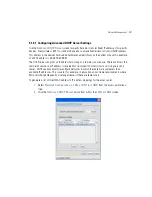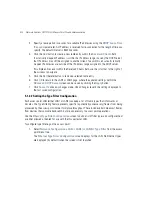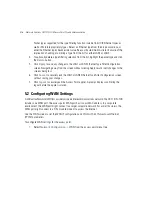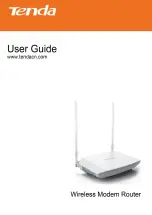
Network Management
5-5
6.
Click
Apply
to save any changes to the LAN Configuration screen. Navigating away from
the screen without clicking the Apply button results in all changes to the screen being lost
if the prompts are ignored.
7.
Click
Undo Changes
(if necessary) to undo any changes made. Undo Changes reverts the
settings displayed on the LAN configuration screen to the last saved configuration.
8.
Click
Logout
to securely exit the access point Access Point applet. A prompt displays
confirming the logout before the applet is closed.
5.1.1 Configuring VLAN Support
A
Virtual Local Area Network (VLAN)
is a means to electronically separate data on the same access
point from a single broadcast domain into separate broadcast domains. The access point can group
devices on one or more WLANs so that they can communicate as if they were attached to the same
wire, when in fact they are located on a different LAN segment. Because VLANs are based on logical
instead of physical connections, they are extremely flexible. By using a VLAN, you can group by
logical function instead of physical location. A maximum of 16 VLANs can be supported on the access
point. An administrator can map 16 WLANs to 16 VLANs and enable or disable dynamic VLAN
assignment.
VLANs enable organizations to share network resources in various network segments within large
areas (airports, shopping malls, etc.). A VLAN is a group of clients with a common set of requirements
independent of their physical location. VLANs have the same attributes as physical LANs, but they
enable system administrators to group MUs even when they are not members of the same network
segment.
The access point assignment of VLANs can be implemented using Static or Dynamic assignments
(often referred to as memberships) for individual WLANs. Both methods have their advantages and
disadvantages. Static VLAN membership is perhaps the most widely used method because of the
relatively small administration overhead and security it provides. With Static VLANs, you manually
assign individual WLANs to individual VLANs.
full duplex
Select this option to transmit data to and from the access point at
the same time. Using full duplex, the access point can send data
over its LAN port while receiving data as well.
NOTE
A WLAN supporting a mesh network does not need to be assigned to a
particular VLAN, as all the traffic proliferating the mesh network is
already trunked. However, if MUs are to be connected to the Mesh WLAN,
the WLAN will need to be tied to a VLAN.
Содержание P-7131N-FGR
Страница 1: ...Motorola Solutions AP 7131N FGR Product Reference Guide M ...
Страница 3: ...AP 7131N FGR Access Point Product Reference Guide ...
Страница 4: ......
Страница 14: ...Motorola Solutions AP 7131N FGR Access Point Product Reference Guide 10 ...
Страница 46: ...Motorola Solutions AP 7131N FGR Access Point Product Reference Guide 1 30 ...
Страница 57: ...Hardware Installation 2 11 ...
Страница 70: ...Motorola Solutions AP 7131N FGR Access Point Product Reference Guide 2 24 ...
Страница 90: ...Motorola Solutions AP 7131N FGR Access Point Product Reference Guide 3 20 ...
Страница 224: ...Motorola Solutions AP 7131N FGR Access Point Product Reference Guide 5 78 ...
Страница 296: ...Motorola Solutions AP 7131N FGR Access Point Product Reference Guide 6 72 ...
Страница 639: ...Configuring Mesh Networking 9 23 4 Enable base bridge functionality on the 802 11a n radio Radio 2 ...
Страница 692: ...Motorola Solutions AP 7131N FGR Access Point Product Reference Guide B 10 ...
Страница 699: ......
















































